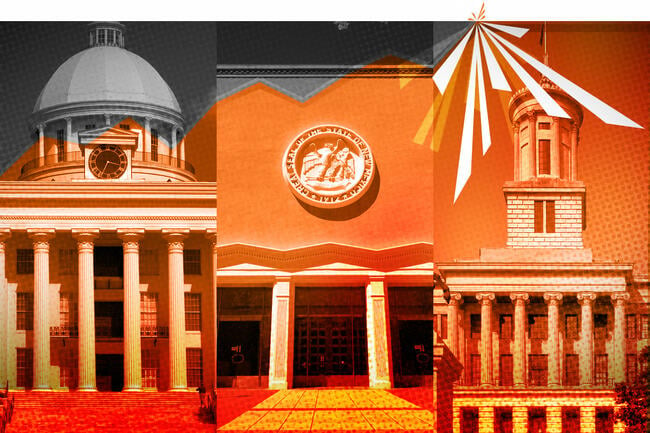You have /5 articles left.
Sign up for a free account or log in.

State funding rose for the fifth consecutive year in fiscal 2024.
Photo illustration by Justin Morrison/Inside Higher Ed | George F. Landegger, Carol M. Highsmith/Library of Congress | Getty Images
State support for higher education rose for the fifth year in a row last year, putting it 18 percent above pre-pandemic levels, according to a new report. But between major federal spending cuts and tightening state budgets, experts worry it may be the last gasp of the post-pandemic funding surge—and that public institutions can’t make up for it with rapidly declining tuition revenue.
The State Higher Education Finance report, released annually by the State Higher Education Executive Officers Association, found that state higher ed funding rose by a slight 0.8 percent last year for a total of $139.1 billion and $11,683 per full-time student. Although the total amount of state support for higher ed increased slightly nationwide, it declined in half the states and Washington, D.C.
The report also tracks enrollments at public higher ed institutions, which rose by 2.3 percent—the first increase in 12 years and one that reverberated in 44 states. However, national levels are still about 11 percent below their peak in 2011. Community college enrollment rose by 5 percent in fiscal year 2024, while four-year enrollment grew by 1.7 percent. Inversely, state appropriations per student at community colleges dropped by 3 percent and rose 1.8 percent at four-year institutions.
At the same time, tuition revenue at public colleges fell by 3.7 percent in fiscal 2024, the largest single decline since SHEEO began tracking the data in 1980. The share of public college revenue supported by student fees and tuition fell below 40 percent last year for the first time since 2010. In the last five years, public college tuition revenue has declined by more than 8 percent.
That means public colleges are more reliant on state funding than ever. While those budgets have increased for five straight years, a number of factors make that trend unlikely to continue, including the depletion of pandemic stimulus funds and the Trump administration’s federal spending cuts, which could put pressure on state budgets.
“With uncertainty on the horizon for federal and state budgets alike, we know states will be under greater pressure to fund higher education,” SHEEO president Robert Anderson wrote in a statement. “We hope lawmakers will continue to view public higher education as an investment in their state’s future workforce.”
Robert Kelchen, a professor and head of the Department of Educational Leadership and Policy at the University of Tennessee at Knoxville, said FY24 is “likely to be the best fiscal year we’ll see for higher education funding for a while” and that public colleges can’t rely on tuition or enrollments to make up for the potential decline.
“I’m worried about the ability of public colleges to raise revenue,” he said. “Going forward, we’ll see more states with flat funding, which leaves tuition as the other key revenue source, and most institutions are unable to increase tuition.”
Florida public colleges had the lowest tuition revenue at less than $2,500 per full-time student, while Delaware had the highest at nearly $20,000.
The report attributes the five-year increase in state funding per full-time student to “three notable trends: increasing state commitments to higher education funding, a sharp decline in [full-time-equivalent] enrollment, and generous federal stimulus funding.”
Federal stimulus funds made up just 0.4 percent of state higher ed funding last year, a decrease of 63 percent and likely the last dregs of the pandemic aid that has helped public colleges avoid more severe budget cuts.
About 10 percent of state higher ed spending went to financial aid programs in FY24. State spending on financial aid rose 4.8 percent per full-time student across the board, with a 6.1 percent increase at four-year colleges and a 1.2 percent bump at community colleges.
What Could Replace State Funds?
Although college sticker prices have been steadily rising at private universities, public institutions have had a harder time adjusting their costs—which, according to SHEF data, have risen less than the rate of inflation in recent years.
That’s due to a number of factors, including state-imposed tuition freezes, pressure from legislators in charge of budgets, students’ greater financial aid needs and the use of tuition discounts to boost lagging enrollment.
With tuition at a ceiling and state funding potentially reaching one as well, enrollment growth would seem to be the main avenue left to public colleges hoping to boost revenue. But, between demographic declines and Americans’ ever-growing skepticism of higher education’s value, that’s a significant challenge in its own right.
Some public colleges are boosting enrollment, especially two-year institutions expanding their online offerings. But tuition makes up a significantly smaller portion of community college budgets, and institutions that have been losing students and tuition, like regional public universities, are facing much stronger headwinds. Even large universities are struggling to make room for as many students as they need to keep revenue stable or growing.
Texas A&M University, for instance, announced in January that it would pause enrollment increases in order to “rightsize” after growing its enrollment by 30 percent in a decade. A&M is also operating under a state-imposed tuition freeze enacted in 2023 and recently extended to 2027.
“A pretty limited set of institutions have the ability to substantially increase enrollment,” Kelchen said. “It’s the big flagships that have the ability, but even many of them are running into capacity challenges after years of rapid growth.”





